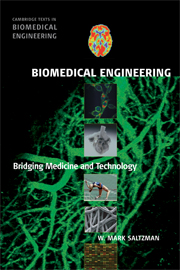Book contents
- Frontmatter
- Contents
- Preface
- Acknowledgments
- Abbreviations and Acronyms
- 1 Introduction: What Is Biomedical Engineering?
- PART 1 MOLECULAR AND CELLULAR PRINCIPLES
- PART 2 PHYSIOLOGICAL PRINCIPLES
- 6 Communication Systems in the Body
- 7 Engineering Balances: Respiration and Digestion
- 8 Circulation
- 9 Removal of Molecules from the Body
- PART 3 BIOMEDICAL ENGINEERING
- Appendix A Physiological Parameters
- Appendix B Chemical Parameters
- Appendix C Units and Conversion Factors
- Index
- Plate section
- References
7 - Engineering Balances: Respiration and Digestion
from PART 2 - PHYSIOLOGICAL PRINCIPLES
- Frontmatter
- Contents
- Preface
- Acknowledgments
- Abbreviations and Acronyms
- 1 Introduction: What Is Biomedical Engineering?
- PART 1 MOLECULAR AND CELLULAR PRINCIPLES
- PART 2 PHYSIOLOGICAL PRINCIPLES
- 6 Communication Systems in the Body
- 7 Engineering Balances: Respiration and Digestion
- 8 Circulation
- 9 Removal of Molecules from the Body
- PART 3 BIOMEDICAL ENGINEERING
- Appendix A Physiological Parameters
- Appendix B Chemical Parameters
- Appendix C Units and Conversion Factors
- Index
- Plate section
- References
Summary
LEARNING OBJECTIVES
After reading this chapter, you should:
Understand the concepts of an engineering system, system boundaries, and the differences between open and closed systems.
Be familiar with the concepts of homeostasis and steady state and be able to distinguish equilibrium from steady state.
Understand the concepts of external and internal respiration.
Be familiar with air volumes and flow rates in the lungs.
Understand how oxygen is carried by blood and the quantitative relationships describing oxygen concentration.
Understand the relationship between carbon dioxide, bicarbonate ion, and pH in body fluids.
Understand the diffusing capacity of the lung and how it relates to the properties of the respiratory membrane.
Understand how the structure of the digestive organs (stomach, small intestine, large intestine, pancreas, and liver) is related to their functions in digestion.
Understand the role of enzymes in digestion, and the importance of enzyme activation after secretion (i.e., the value of zymogens).
Understand the role of reactor models in understanding digestion and absorption of nutrients.
Prelude
Humans eat, drink, and breathe to bring into their bodies the raw materials for growth, repair, and generation of the energy necessary for life and the actions that bring pleasure to life. This chapter provides an overview of human nutrition and respiration from the perspective of biomedical engineering (BME). The human body is an elegant machine that requires inputs for sustained operation. What are the processes responsible for input of nutrients and raw materials? How are molecular nutrients extracted from ingested materials? How are these processes controlled?
- Type
- Chapter
- Information
- Biomedical EngineeringBridging Medicine and Technology, pp. 247 - 298Publisher: Cambridge University PressPrint publication year: 2009



